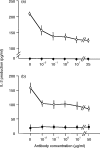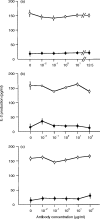Inhibitory effect of interleukin-16 on interleukin-2 production by CD4+ T cells
- PMID: 10233698
- PMCID: PMC2326730
- DOI: 10.1046/j.1365-2567.1999.00693.x
Inhibitory effect of interleukin-16 on interleukin-2 production by CD4+ T cells
Abstract
Signalling through CD4 by human immunodeficiency virus (HIV)-1 envelope glycoprotein (gpl20) and/or anti-CD4 antibodies can promote T-cell activation and anergy. Interleukin (IL)-16 is a competence growth factor for CD4+ T cells that can induce a G0 to G1 cell cycle transition but cannot induce cell division. The receptor of this cytokine is thought to be the CD4 molecule, although the binding epitope of IL-16 differs from that of HIV. We have demonstrated that both HIV-1/gp120 and IL-16 induced CD4+ T-cell dysfunction, as indicated by suppression of mitogen-induced IL-2 production. Two anti-CD4 antibodies with different binding sites on CD4 also showed an inhibitory effect on IL-2 production. These results indicate that promotion of CD4+ T-cell anergy via the CD4 molecule does not depend on the binding sites of the CD4 ligands.
Figures




Similar articles
-
Role of tumour necrosis factor-alpha (TNF-alpha) in the induction of HIV-1 gp120-mediated CD4+ T cell anergy.Clin Exp Immunol. 1997 Jul;109(1):41-6. doi: 10.1046/j.1365-2249.1997.4231325.x. Clin Exp Immunol. 1997. PMID: 9218822 Free PMC article.
-
Regulation of the serine-base exchange enzyme system by CD4: effects of monoclonal antibodies, jacalin, interleukin 16 and the HIV membrane protein gp120.Biochem J. 1998 Jan 1;329 ( Pt 1)(Pt 1):49-54. doi: 10.1042/bj3290049. Biochem J. 1998. PMID: 9405274 Free PMC article.
-
Human immunodeficiency virus-1 envelope glycoproteins and anti-CD4 antibodies inhibit interleukin-2-induced Jak/STAT signalling in human CD4 T lymphocytes.Clin Exp Immunol. 2003 Mar;131(3):422-7. doi: 10.1046/j.1365-2249.2003.02065.x. Clin Exp Immunol. 2003. PMID: 12605694 Free PMC article.
-
CD4 and CD8: modulators of T-cell receptor recognition of antigen and of immune responses?Curr Opin Immunol. 1998 Feb;10(1):82-7. doi: 10.1016/s0952-7915(98)80036-8. Curr Opin Immunol. 1998. PMID: 9523116 Review.
-
Induction of lymphomonocyte activation by HIV-1 glycoprotein gp120. Possible role in AIDS pathogenesis.J Biol Regul Homeost Agents. 1996 Oct-Dec;10(4):83-91. J Biol Regul Homeost Agents. 1996. PMID: 9604776 Review.
Cited by
-
Fibroblast biology. Role of synovial fibroblasts in the pathogenesis of rheumatoid arthritis.Arthritis Res. 2000;2(5):361-7. doi: 10.1186/ar113. Epub 2000 Jun 8. Arthritis Res. 2000. PMID: 11094449 Free PMC article. Review.
-
Role of interleukin-16 in human diseases: a novel potential therapeutic target.Front Immunol. 2025 Jun 2;16:1524026. doi: 10.3389/fimmu.2025.1524026. eCollection 2025. Front Immunol. 2025. PMID: 40529362 Free PMC article. Review.
-
Mendelian randomization reveals interactions of the blood proteome and immunome in mitral valve prolapse.Commun Med (Lond). 2024 Jun 6;4(1):108. doi: 10.1038/s43856-024-00530-x. Commun Med (Lond). 2024. PMID: 38844506 Free PMC article.
-
Immune abnormalities induced by human endogenous retroviral peptides: with reference to the pathogenesis of systemic lupus erythematosus.J Clin Immunol. 2003 Sep;23(5):371-6. doi: 10.1023/a:1025369500466. J Clin Immunol. 2003. PMID: 14601645
-
Macrophages in rheumatoid arthritis.Arthritis Res. 2000;2(3):189-202. doi: 10.1186/ar86. Epub 2000 Apr 12. Arthritis Res. 2000. PMID: 11094428 Free PMC article. Review.
References
-
- Center DM, Cruikshank WW. Modulation of lymphocyte migration by human lymphokines. J Immunol. 1982;128:2563. - PubMed
-
- Cruikshank WW, Center DM. Modulation of lymphocyte migration by human lymphokines. Purification of a lymphotactic factor (LCF) J Immunol. 1982;128:2569. - PubMed
-
- Cruikshank WW, Berman JS, Theodore AC, Bernardo J, Center DM. Lymphokine activation of T4+ T lymphocytes and monocytes. J Immunol. 1987;138:3817. - PubMed
Publication types
MeSH terms
Substances
LinkOut - more resources
Full Text Sources
Research Materials
Miscellaneous

